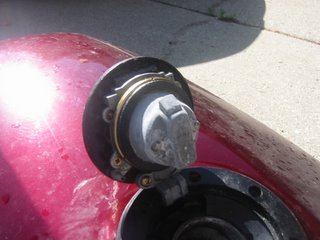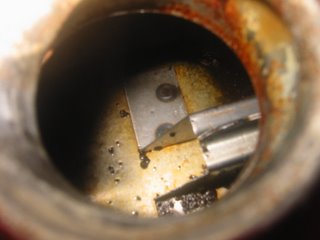When I picked up the Concours, we couldn't open the tank's gas cap (is that what you call them on a bike?). The key would turn to the point of engaging the cam, or whatever's inside one of those locks that retracts the arm that hold the cap in place, and then stop.
After transporting the bike back to Ohio, I first stopped at a local locksmith before heading home. They were able to pick the lock for me, and turn it using a screwdriver (i.e., applying so much torque that would normally have snapped the key). It worked, and the cap opened up to reveal what 8-years of gasoline vapors will do to whatever type of metal that is made of (aluminum, I think).
I don't have pictures of immediately after, but it seriously looked like someone had smeared a thick layer of silver Anti-Seize Compound all around the filler hole. In retrospect (after cleaning it up), I don't think that the vapors necessarily consumed the metal, because it doesn't look like it needs replaced now. But, the vapors definitely precipitated into some kind of sludge.
Here's what the filler cap looked like this morning (imagine being covered by so much sludge that you couldn't make out any features, and that's pretty much what it looked like when I brought her home):

Josh had warned me a while ago that the tank would likely be rusted, and will need cleaned/coated. He was right. Last week, I siphoned out all of the remaining gasoline (3.5 gallons) and with it came a bunch of rust. I'm not sure how you properly dispose of old gasoline, but I've been using a 1:3 ratio of that stuff (filtered) and new gasoline in my lawnmower. ;-)

Luckily, the Concours has a vacuum-operated petcock valve, so the tank was not emptying into the carbs over the past 8-years. I did pull the carbs, though, just to make sure. They looked pretty clean (albeit, I did not use a microscope to examine jets or anything). A little carb cleaner will likely be required once the bike is running again.
As for cleaning and restoring the tank: I browsed around the COG forums and found a few suggestions. One that really interested me was a Motorcycle Fuel Tank Repair Kit from POR-15. $40 later, and the UPS man delivered the box to my house.

Inside was a cleaner, a rust remover/metal preparer, and a sealant:

I did the first step of the tank restoration this morning: Cleaning using a hot solution of the Marine Clean product (1 qt Marine Clean to 1 qt hot water).
One little challenge is how to seal the tank off. The Connie has holes for both the petcock valve and a fuel-level sender. The POR-15 instructions say to just use duct tape. I did, but I also re-enforced with some aluminum (from a pop can). The larger of the holes (fuel sender) leaked during the process, so I might need to use some RTV sealant for subsequent steps.

The Marine Clean dissolves varnish and sludge, and is really just a prep for the next step that does the heavy lifting of eliminating rust. I've got to say that I'm impressed. Marine Clean is clear going in, but look at a sample of what came out:

I'm going to let the tank dry out in the sun, and will probably do the next step tomorrow. There might be some flash rusting, but the Metal Ready will take care of it. The other purpose of Metal Ready is to change the pH of the metal from basic, which Marine Clean (being alkaline) left it, to acidic, which the sealer requires in order to adhere.









